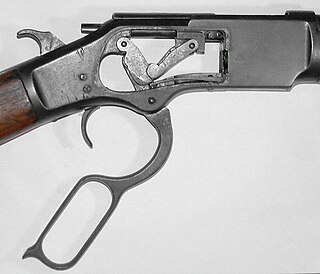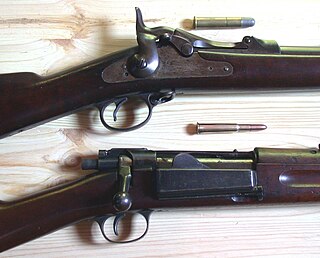
The Krag–Jørgensen is a repeating bolt-action rifle designed by the Norwegians Ole Herman Johannes Krag and Erik Jørgensen in the late 19th century. It was adopted as a standard arm by Norway, Denmark, and the United States. About 300 were delivered to Boer forces of the South African Republic.

In firearm designs, the term single-shot refers to guns that can hold only a single round of ammunition inside and thus must be reloaded manually after every shot. Compared to multi-shot repeating firearms ("repeaters"), single-shot designs have no moving parts other than the trigger, hammer/firing pin or frizzen, and therefore do not need a sizable receiver behind the barrel to accommodate a moving action, making them far less complex and more robust than revolvers or magazine/belt-fed firearms, but also with much slower rates of fire.

A semi-automatic rifle is an autoloading rifle that fires a single cartridge with each pull of the trigger, and uses part of the fired cartridge's energy to eject the case and load another cartridge into the chamber. In contrast, a bolt-action rifle requires the user to cycle the bolt manually before they can fire a second time, and a fully automatic rifle fires continuously until the trigger is released.

Bolt-action is a type of manual firearm action that is operated by directly manipulating the bolt via a bolt handle, which is most commonly placed on the right-hand side of the firearm.

In firearms terminology, an action is the functional mechanism of a breech-loading firearm that handles the ammunition cartridges, or the method by which that mechanism works. Actions are technically not present on muzzleloaders, as all those are single-shot firearms with a closed off breech with the powder and projectile manually loaded from the muzzle. Instead, the muzzleloader ignition mechanism is referred to as the lock.

The Arisaka rifle is a family of Japanese military bolt-action service rifles, which were produced and used since approximately 1897, when it replaced the Murata rifle family, until the end of World War II in 1945. The most common models include the Type 38 chambered for the 6.5×50mmSR Type 38 cartridge, and the Type 99 chambered for the 7.7×58mm Type 99 cartridge, which is comparable in power to a modern .308 Winchester round.
Winchester rifle is a comprehensive term describing a series of lever action repeating rifles manufactured by the Winchester Repeating Arms Company. Developed from the 1860 Henry rifle, Winchester rifles were among the earliest repeaters. The Model 1873 was particularly successful, being marketed by the manufacturer as "The Gun That Won the West".
A semi-automatic firearm, also called a self-loading or autoloading firearm, is a repeating firearm whose action mechanism automatically loads a following round of cartridge into the chamber (self-loading) and prepares it for subsequent firing, but requires the shooter to manually actuate the trigger in order to discharge each shot. Typically, this involves the weapon's action utilizing the excess energy released during the preceding shot to unlock and move the bolt, extracting and ejecting the spent cartridge case from the chamber, re-cocking the firing mechanism, and loading a new cartridge into the firing chamber, all without input from the user. To fire again, however, the user must actively release the trigger, allow it to "reset", before pulling the trigger again to fire off the next round. As a result, each trigger pull only discharges a single round from a semi-automatic weapon, as opposed to a fully automatic weapon, which will shoot continuously as long as the ammunition is replete and the trigger is kept depressed.

The M1903 Springfield, officially the United States Rifle, Caliber .30-06, Model 1903, is an American five-round magazine-fed, bolt-action service repeating rifle, used primarily during the first half of the 20th century.

Lever action is a type of action for repeating firearms that uses a manually operated cocking handle located around the trigger guard area that pivots forward to move the bolt via internal linkages, which will feed and extract cartridges into and out of the chamber, and cock the firing pin mechanism. This contrasts to other type of repeating actions such as the bolt-action, pump-action, semi-automatic, fully automatic, and/or burst mode actions. A firearm using this operating mechanism is colloquially referred to as a levergun.

The Remington M1867 was a rolling-block rifle, the first rifle using metallic cartridges to be adopted by the Norwegian and Swedish armies. Nominally it had a caliber of 4 decimal lines, but the actual caliber was 3.88 Norwegian decimal lines or 4.1 Swedish decimal lines (12.17 mm), and it fired a rimfire round with a 12.615 mm lead bullet. The 12.17 mm caliber was chosen because the Swedish army had approximately 30,000 new muzzle-loading M1860 and breech-loading M1864 rifles in 12.17 mm caliber in stock, rifles that were suitable for conversion to M1867 rolling-block rifles. With the exception of the first 10,000 rifles and 20,000 actions, which were made by Remington in the US, all Remington M1867 rifles and carbines were made under license in Norway and Sweden, by Kongsberg Vaapenfabrik in Norway, and by Husqvarna Vapenfabriks Aktiebolag and Carl Gustafs stads Gevärsfaktori in Sweden with the two Swedish manufacturers producing about 80% of the weapons.
The Springfield Model 1873 was the first standard-issue breech-loading rifle adopted by the United States Army. The rifle, in both full-length and carbine versions, was widely used in subsequent battles against Native Americans.

The M1917 Enfield, the "American Enfield", formally named "United States Rifle, cal .30, Model of 1917" is an American modification and production of the .303-inch Pattern 1914 Enfield (P14) rifle, which was developed and manufactured during the period 1917–1918. Numerically, it was the main rifle used by the American Expeditionary Forces in Europe during World War I. The Danish Sirius Dog Sled Patrol on Greenland still use the M1917, which performs reliably in Arctic conditions, as their service weapon.
The Winchester Model 1894 rifle is a lever-action repeating rifle that became one of the most famous and popular hunting rifles of all time. It was designed by John Browning in 1894 and originally chambered to fire two metallic black powder cartridges, the .32-40 Winchester and .38-55 Winchester. It was the first rifle to chamber the smokeless powder round, the .30 WCF in 1895. In 1901, Winchester created the new .32 Winchester Special caliber with production of rifles starting in 1902.

The Springfield Model 1892–99 Krag–Jørgensen rifle is a Norwegian-designed bolt-action rifle that was adopted in 1892 as the standard United States Army military longarm, chambered for U.S. caliber .30-40 Krag cartridges. All versions and variants were manufactured under license by the Springfield Armory between 1892 and 1903 and famously served as the longarm during the Spanish–American War.
The Winchester Model 1895 is an American lever-action repeating firearm developed and manufactured by the Winchester Repeating Arms Company in the late 19th century, chambered for a number of full-size military and hunting cartridges such as 7.62×54mmR, .303 British, .30-03, .30 Army, .30-06, .35 Winchester, .38-72 Winchester, .40-72 Winchester and .405 Winchester.

The Winchester Model 1907 is a blowback-operated, semi-automatic rifle produced by the Winchester Repeating Arms Company beginning in 1907 with production ending in 1957. It fired a cartridge of intermediate power, cycled through a semi-automatic operating mechanism, fed from a 5, 10, or 15 round detachable box magazine located immediately forward of the trigger guard. In size and handling, it is much like an M1 carbine, though the 1907 is heavier and fires a much harder hitting round.
The term Joslyn Rifle refers to a series of rifles produced in the mid-19th century. The term is often used to refer specifically to the Joslyn Model 1861/1862, which was the first mass-produced breech-loading rifle produced at the Springfield Armory.

The Evans Repeating Rifle was a lever-action repeating rifle designed by Warren R. Evans as a high capacity rifle.

The Colt-Burgess rifle, also known as the 1883 Burgess rifle or simply the Burgess rifle, is a lever-action repeating rifle produced by Colt's Patent Firearms Manufacturing Company between 1883 and 1885. The Burgess rifle was Colt's only entrance into the lever-action rifle market, produced to compete with Winchester Repeating Arms Company's line of popular rifles. The 1883 Burgess rifle was designed and patented by Andrew Burgess, an American firearms designer and photographer, who sold the design to Colt.














